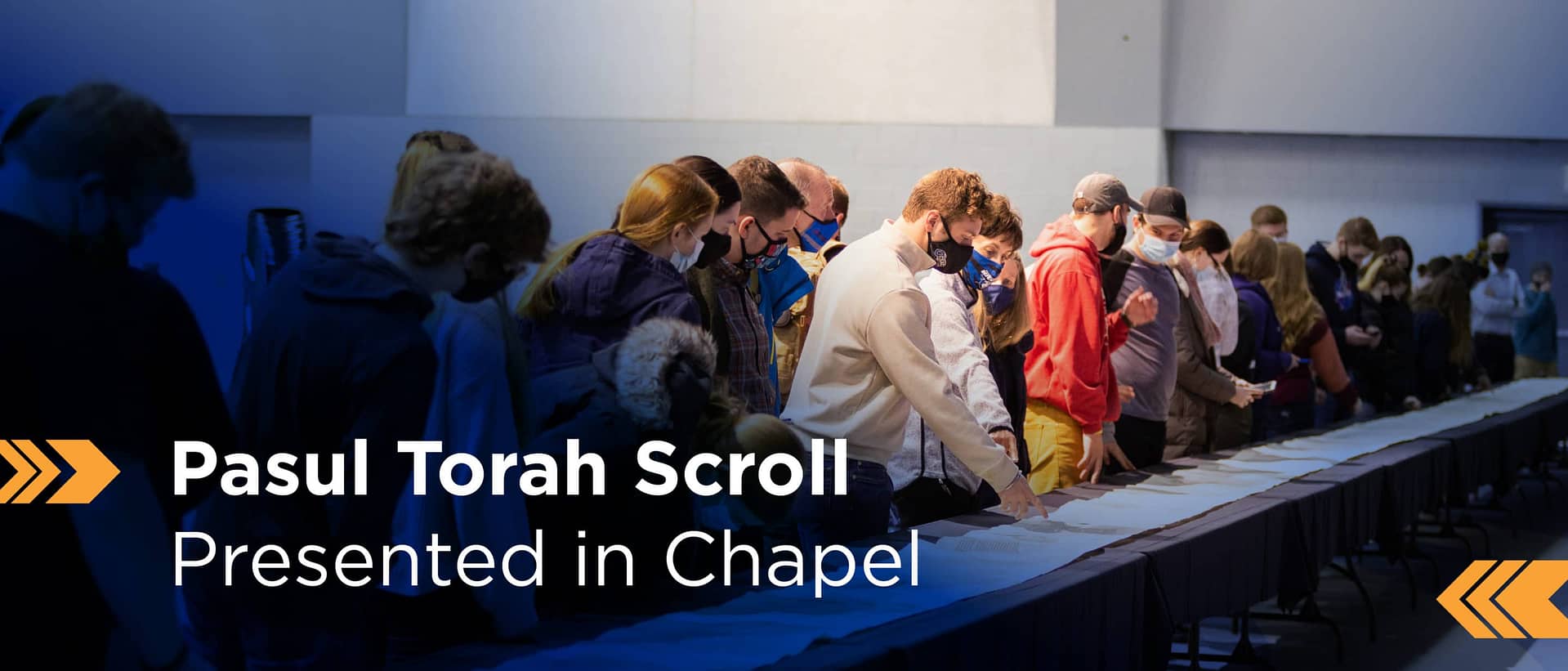On January 13, 2022, students and employees at Clarks Summit University had the opportunity to observe a pasul Torah scroll. The scroll was gifted to CSU by God’s Ancient Library, a collection of rare Torah scrolls founded by Ken and Barb Larson. Since 2013, God’s Ancient Library has gifted more than 80 Torahs to universities, seminaries, museums and other organizations.
Dr. Jim Lytle, CSU president, presented the scroll in chapel alongside Dr. Kenneth Gardoski, director of seminary doctoral programs, and Dr. Mark McGinniss, assistant seminary dean. They have extensive experience studying theology, especially the Hebrew text and Old Testament. Gardoski and McGuiness unrolled the 98-foot-long scroll in front of the audience and highlighted the historical and biblical significance of the Torah through conversation with Lytle.
The three presenters showcased the intricate language, format and diction of the Torah. Common passages, such as the Ten Commandments in Exodus or the well-studied Deuteronomy 6, were used to familiarize the audience with the Hebrew language and its system in context of the scroll.
Typically used in a synagogue when kosher, CSU’s scroll is pasul, or no longer fit for Jewish ceremonial use. The scroll was thought to be copied in Russia circa 1900. A few dozen students volunteered to hold up the 45 panels of the historic piece during chapel, and all students and employees were invited to touch the edges and observe the scroll up close after the presentation.
The Torah is a liturgical scroll comprised of the Pentateuch, or the first five books of the Bible. While the English translations of these books vary, each Torah scroll contains the same text as the original text of Moses. Lytle portrayed this significance in a dialogue with McGuiness: “If we were to travel 1,000 years backwards to read a Torah in a synagogue, would there be any difference?” McGuiness answered, “None.”
The Torah, written in biblical Hebrew, contains more than 300,000 hand-inked letters that must be copied correctly by scribes called “sofers.” Due to the sacred nature of the Torah, a slight omission or false injection alters the meaning of the text. In addition to the strict syntax guidelines, sofers also followed detailed regulation of ink, writing device and scroll material, after memorizing 4,000 regulations related to their role.
The gravity of the Torah is eternal due to the meticulous precision of sofers. Students who attended the chapel service were able to observe the text from which their education is derived and feel the work of centuries at their fingertips. The understanding of the scroll changed the appreciation not only for the intricacy of the Bible, but for the historical and biblical preservation of sacred texts.
Gardoski noted that it would be easy for the audience to think of the scroll as simply a museum piece or relic; however, he called students and employees to see how it represents so much more. “It’s because of handwritten documents, handwritten manuscripts like this, that you and I even have access to God’s Word today,” he said. “It’s these kinds of handwritten manuscripts that the Jews faithfully, carefully produced—thousands and thousands of hours…to produce one of these scrolls…The Jews preserved God’s Word. They passed it down from generation to generation through millennia. It’s manuscripts like these that serve as the bridge between God’s Word as He originally gave it starting with Moses and us and the copies of Scripture that we use today in our English translations.”
He referenced I Timothy 3:16–17 (ESV): “All Scripture is breathed out by God and profitable for teaching, for reproof, for correction, and for training in righteousness, that the man of God may be complete, equipped for every good work.”
“It’s the Hebrew bible starting with this, the five books of Moses, the Torah. This was the Bible of Paul and the Apostles. This was the Bible of Jesus in His time. This was the Word of God that Jesus knew and that Jesus memorized and that Jesus loved,” explained Gardoski. It’s foundational Scripture for you and me today—the same Scripture. If I claim to know Jesus, then I need to know the Word of Jesus—it’s this Scripture.”
Watch the recording of the chapel on Facebook.
By Kevin Waldron, Communications-Writing Major





Request Info
Visit
Apply Now
Give